洛可可家具
- 格式:ppt
- 大小:8.90 MB
- 文档页数:28
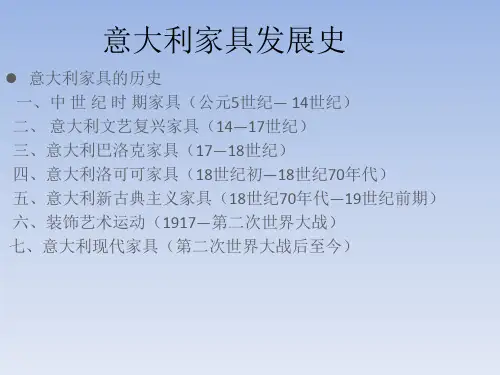
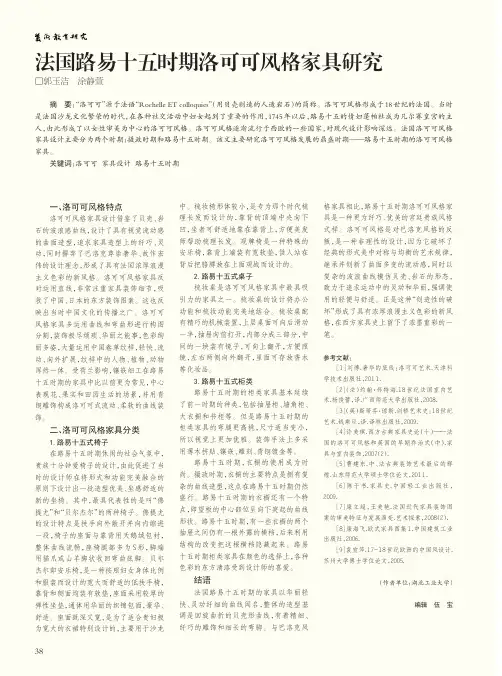
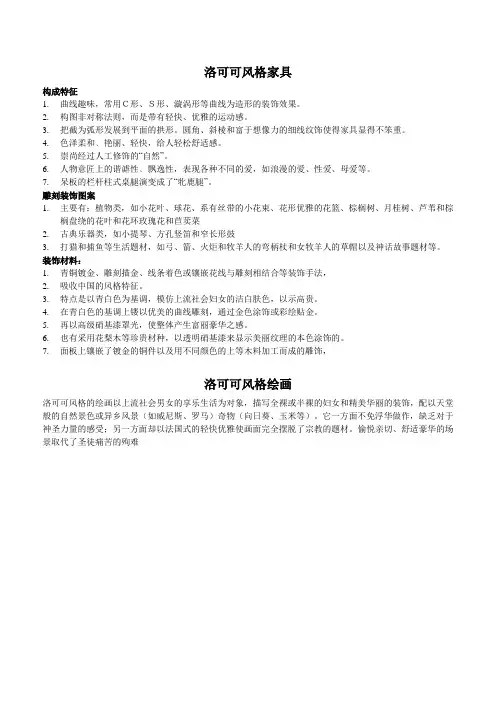
洛可可风格家具构成特征1.曲线趣味,常用C形、S形、漩涡形等曲线为造形的装饰效果。
2.构图非对称法则,而是带有轻快、优雅的运动感。
3.把截为弧形发展到平面的拱形。
圆角、斜棱和富于想像力的细线纹饰使得家具显得不笨重。
4.色泽柔和﹑艳丽、轻快,给人轻松舒适感。
5.崇尚经过人工修饰的“自然”。
6.人物意匠上的谐谑性﹑飘逸性,表现各种不同的爱,如浪漫的爱、性爱、母爱等。
7.呆板的栏杆柱式桌腿演变成了“牝鹿腿”。
雕刻装饰图案1.主要有:植物类,如小花叶、球花、系有丝带的小花束、花形优雅的花篮、棕榈树、月桂树、芦苇和棕榈盘绕的花叶和花环玫瑰花和苣荬菜2.古典乐器类,如小提琴、方孔竖笛和窄长形鼓3.打猎和捕鱼等生活题材,如弓、箭、火炬和牧羊人的弯柄杖和女牧羊人的草帽以及神话故事题材等。
装饰材料:1.青铜镀金、雕刻描金、线条着色或镶嵌花线与雕刻相结合等装饰手法,2.吸收中国的风格特征。
3.特点是以青白色为基调,模仿上流社会妇女的洁白肤色,以示高贵。
4.在青白色的基调上镂以优美的曲线雕刻,通过金色涂饰或彩绘贴金。
5.再以高级硝基漆罩光,使整体产生富丽豪华之感。
6.也有采用花梨木等珍贵材种,以透明硝基漆来显示美丽纹理的本色涂饰的。
7.面板上镶嵌了镀金的铜件以及用不同颜色的上等木料加工而成的雕饰,洛可可风格绘画洛可可风格的绘画以上流社会男女的享乐生活为对象,描写全裸或半裸的妇女和精美华丽的装饰,配以天堂般的自然景色或异乡风景(如威尼斯、罗马)奇物(向日葵、玉米等)。
它一方面不免浮华做作,缺乏对于神圣力量的感受;另一方面却以法国式的轻快优雅使画面完全摆脱了宗教的题材。
愉悦亲切、舒适豪华的场景取代了圣徒痛苦的殉难一、洛可可椅类家具路易十五时期中有扶手椅、安乐椅、长沙发、长椅、躺椅等大量的椅子家具。
适应沙龙文化的小型集会、家庭聚会,并逐渐形成的以上层社会女性为主的亲密化的社会交往。
路易十五时期的椅子已是完全成熟化的洛可可家具,其形态更加优美,完全开放的凸曲线构成,华丽的织物包面,并且将最优美的形式与最可能的舒适效果灵巧地结合在一起。

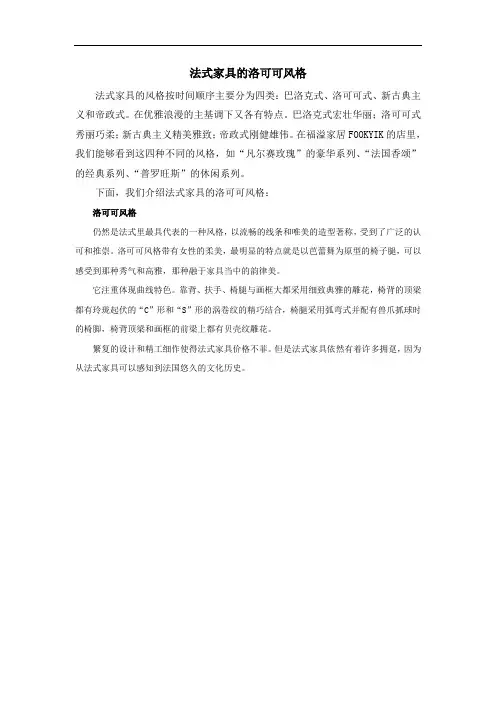
法式家具的洛可可风格
法式家具的风格按时间顺序主要分为四类:巴洛克式、洛可可式、新古典主义和帝政式。
在优雅浪漫的主基调下又各有特点。
巴洛克式宏壮华丽;洛可可式秀丽巧柔;新古典主义精美雅致;帝政式刚健雄伟。
在福溢家居FOOKYIK的店里,我们能够看到这四种不同的风格,如“凡尔赛玫瑰”的豪华系列、“法国香颂”的经典系列、“普罗旺斯”的休闲系列。
下面,我们介绍法式家具的洛可可风格:
洛可可风格
仍然是法式里最具代表的一种风格,以流畅的线条和唯美的造型著称,受到了广泛的认可和推崇。
洛可可风格带有女性的柔美,最明显的特点就是以芭蕾舞为原型的椅子腿,可以感受到那种秀气和高雅,那种融于家具当中的韵律美。
它注重体现曲线特色。
靠背、扶手、椅腿与画框大都采用细致典雅的雕花,椅背的顶梁都有玲珑起伏的“C”形和“S”形的涡卷纹的精巧结合,椅腿采用弧弯式并配有兽爪抓球时的椅脚,椅背顶梁和画框的前梁上都有贝壳纹雕花。
繁复的设计和精工细作使得法式家具价格不菲。
但是法式家具依然有着许多拥趸,因为从法式家具可以感知到法国悠久的文化历史。

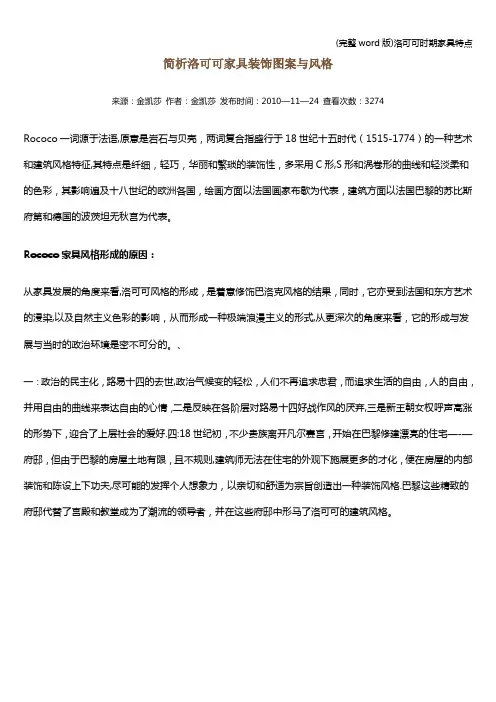
简析洛可可家具装饰图案与风格来源:金凯莎作者:金凯莎发布时间:2010—11—24 查看次数:3274Rococo一词源于法语,原意是岩石与贝壳,两词复合指盛行于18世纪十五时代(1515-1774)的一种艺术和建筑风格特征,其特点是纤细,轻巧,华丽和繁琐的装饰性,多采用C形,S形和涡卷形的曲线和轻淡柔和的色彩,其影响遍及十八世纪的欧洲各国,绘画方面以法国画家布歇为代表,建筑方面以法国巴黎的苏比斯府第和德国的波茨坦无秋宫为代表。
Rococo家具风格形成的原因:从家具发展的角度来看,洛可可风格的形成,是着意修饰巴洛克风格的结果,同时,它亦受到法国和东方艺术的浸染,以及自然主义色彩的影响,从而形成一种极端浪漫主义的形式,从更深次的角度来看,它的形成与发展与当时的政治环境是密不可分的。
、一:政治的民主化,路易十四的去世,政治气候变的轻松,人们不再追求忠君,而追求生活的自由,人的自由,并用自由的曲线来表达自由的心情,二是反映在各阶层对路易十四好战作风的厌弃,三是新王朝女权呼声高涨的形势下,迎合了上层社会的爱好.四:18世纪初,不少贵族离开凡尔赛宫,开始在巴黎修建漂亮的住宅—-—府邸,但由于巴黎的房屋土地有限,且不规则,建筑师无法在住宅的外观下施展更多的才化,便在房屋的内部装饰和陈设上下功夫,尽可能的发挥个人想象力,以亲切和舒适为宗旨创造出一种装饰风格.巴黎这些精致的府邸代替了宫殿和教堂成为了潮流的领导者,并在这些府邸中形马了洛可可的建筑风格。
Rococo家具风格的最显著的特征就是不对称,并以自然界的动物和植物形象作为主要的装饰语言,叶子和花交错穿插在岩石和贝壳之间,外形轮廓不规则的形式遮住了传统的结构,熟悉的雕刻形式与令人耳目一新的新图案有机的融合在一起,常见的装饰题材有植物类,玫瑰花,小花叶,球花,月桂树,芦苇,古典乐器等,弓,打猎和捕鱼的生活题材,神话和故事题材.一般来说,洛可可家具强调表面的装饰设计,使人们的眼睛不注意那些矩形的连接部位,另外,还发展了青铜镀金,雕刻镀金,线条着色或镶嵌花线与雕刻相结合的装饰手法,并适时吸收中国的风格特征,这些做法都致力于追求家具本身的纤巧与华丽,强调适用中的轻巧与舒适,以均衡代替对称,形成了富于浪漫主义色彩的新艺术风格,这类家具以青白色为主要基调,如同上流社会中贵妇们高贵的脸庞,在此基础上以雕刻件和石膏翻模件,金色的自由曲线,贴金彩绘与浮雕和圆雕进行装饰和点缀,并以硝基清漆罩面,这种精雕细作的家个构成了现实社会自由,轻松,浮华绚丽生活场景中不可缺少的元素。
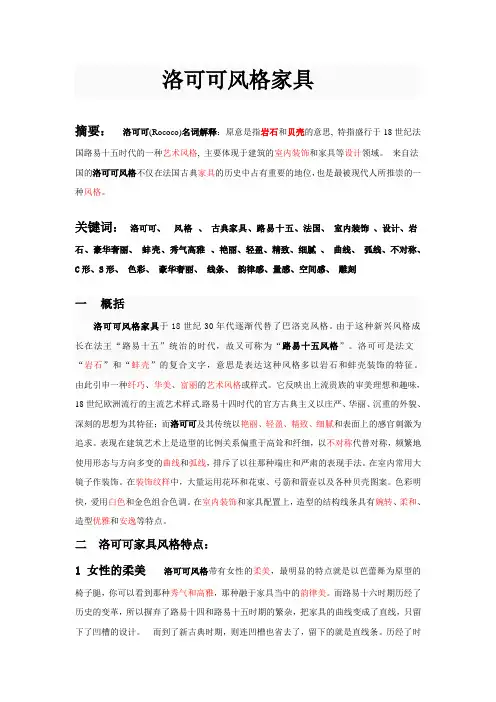
洛可可风格家具摘要:洛可可(Rococo)名词解释:原意是指岩石和贝壳的意思, 特指盛行于18世纪法国路易十五时代的一种艺术风格, 主要体现于建筑的室内装饰和家具等设计领域。
来自法国的洛可可风格不仅在法国古典家具的历史中占有重要的地位,也是最被现代人所推崇的一种风格。
关键词:洛可可、风格、古典家具、路易十五、法国、室内装饰、设计、岩石、豪华奢丽、蚌壳、秀气高雅、艳丽、轻盈、精致、细腻、曲线、弧线、不对称、C形、S形、色彩、豪华奢丽、线条、韵律感、量感、空间感、雕刻一概括洛可可风格家具于18世纪30年代逐渐代替了巴洛克风格。
由于这种新兴风格成长在法王“路易十五”统治的时代,故又可称为“路易十五风格”。
洛可可是法文“岩石”和“蚌壳”的复合文字,意思是表达这种风格多以岩石和蚌壳装饰的特征。
由此引申一种纤巧、华美、富丽的艺术风格或样式。
它反映出上流贵族的审美理想和趣味,18世纪欧洲流行的主流艺术样式.路易十四时代的官方古典主义以庄严、华丽、沉重的外貌、深刻的思想为其特征;而洛可可及其传统以艳丽、轻盈、精致、细腻和表面上的感官刺激为追求。
表现在建筑艺术上是造型的比例关系偏重于高耸和纤细,以不对称代替对称,频繁地使用形态与方向多变的曲线和弧线,排斥了以往那种端庄和严肃的表现手法。
在室内常用大镜子作装饰。
在装饰纹样中,大量运用花环和花束、弓箭和箭壶以及各种贝壳图案。
色彩明快,爱用白色和金色组合色调。
在室内装饰和家具配置上,造型的结构线条具有婉转、柔和、造型优雅和安逸等特点。
二洛可可家具风格特点:1 女性的柔美洛可可风格带有女性的柔美,最明显的特点就是以芭蕾舞为原型的椅子腿,你可以看到那种秀气和高雅,那种融于家具当中的韵律美。
而路易十六时期历经了历史的变革,所以摒弃了路易十四和路易十五时期的繁杂,把家具的曲线变成了直线,只留下了凹槽的设计。
而到了新古典时期,则连凹槽也省去了,留下的就是直线条。
历经了时代的变迁,法国古典家具受到了政治和经济发展的影响,然而洛可可风格仍然是最能代表法国古典家具的一种风格,受到了全世界人们的认可和推崇,也是体现人身份和品位的一种象征。

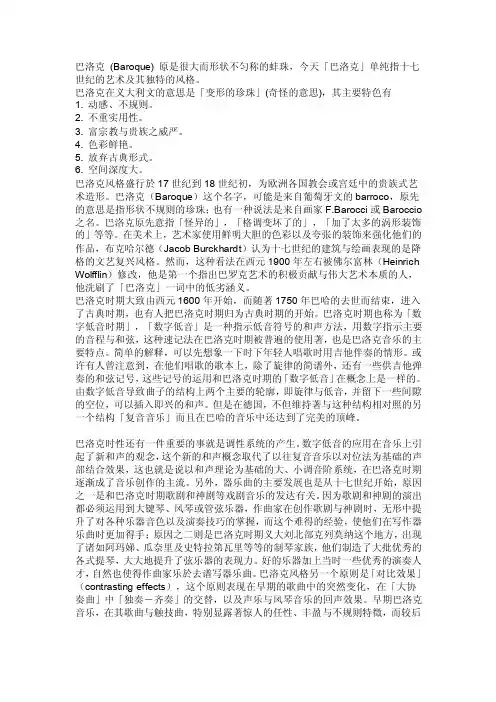
巴洛克(Baroque) 原是很大而形状不匀称的蚌珠,今天「巴洛克」单纯指十七世纪的艺术及其独特的风格。
巴洛克在义大利文的意思是「变形的珍珠」(奇怪的意思),其主要特色有1. 动感、不规则。
2. 不重实用性。
3. 富宗教与贵族之威严。
4. 色彩鲜艳。
5. 放弃古典形式。
6. 空间深度大。
巴洛克风格盛行於17世纪到18世纪初,为欧洲各国教会或宫廷中的贵族式艺术造形。
巴洛克(Baroque)这个名字,可能是来自葡萄牙文的barroco,原先的意思是指形状不规则的珍珠;也有一种说法是来自画家F.Barocci或Baroccio 之名。
巴洛克原先意指「怪异的」,「格调变坏了的」,「加了太多的涡形装饰的」等等。
在美术上,艺术家使用鲜明大胆的色彩以及夸张的装饰来强化他们的作品,布克哈尔德(Jacob Burckhardt)认为十七世纪的建筑与绘画表现的是降格的文艺复兴风格。
然而,这种看法在西元1900年左右被佛尔富林(Heinrich Wolfflin)修改,他是第一个指出巴罗克艺术的积极贡献与伟大艺术本质的人,他洗刷了「巴洛克」一词中的低劣涵义。
巴洛克时期大致由西元1600年开始,而随著1750年巴哈的去世而结束,进入了古典时期,也有人把巴洛克时期归为古典时期的开始。
巴洛克时期也称为「数字低音时期」,「数字低音」是一种指示低音符号的和声方法,用数字指示主要的音程与和弦,这种速记法在巴洛克时期被普遍的使用著,也是巴洛克音乐的主要特点。
简单的解释,可以先想象一下时下年轻人唱歌时用吉他伴奏的情形。
或许有人曾注意到,在他们唱歌的歌本上,除了旋律的简谱外,还有一些供吉他弹奏的和弦记号,这些记号的运用和巴洛克时期的「数字低音」在概念上是一样的。
由数字低音导致曲子的结构上两个主要的轮廓,即旋律与低音,并留下一些间隙的空位,可以插入即兴的和声。
但是在德国,不但维持著与这种结构相对照的另一个结构「复音音乐」而且在巴哈的音乐中还达到了完美的顶峰。
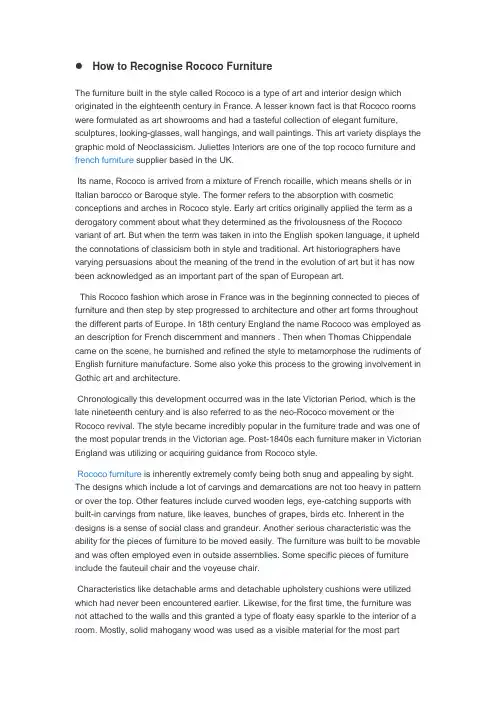
How to Recognise Rococo FurnitureThe furniture built in the style called Rococo is a type of art and interior design which originated in the eighteenth century in France. A lesser known fact is that Rococo rooms were formulated as art showrooms and had a tasteful collection of elegant furniture, sculptures, looking-glasses, wall hangings, and wall paintings. This art variety displays the graphic mold of Neoclassicism. Juliettes Interiors are one of the top rococo furniture and french furniture supplier based in the UK.Its name, Rococo is arrived from a mixture of French rocaille, which means shells or in Italian barocco or Baroque style. The former refers to the absorption with cosmetic conceptions and arches in Rococo style. Early art critics originally applied the term as a derogatory comment about what they determined as the frivolousness of the Rococo variant of art. But when the term was taken in into the English spoken language, it upheld the connotations of classicism both in style and traditional. Art historiographers have varying persuasions about the meaning of the trend in the evolution of art but it has now been acknowledged as an important part of the span of European art.This Rococo fashion which arose in France was in the beginning connected to pieces of furniture and then step by step progressed to architecture and other art forms throughout the different parts of Europe. In 18th century England the name Rococo was employed as an description for French discernment and manners . Then when Thomas Chippendale came on the scene, he burnished and refined the style to metamorphose the rudiments of English furniture manufacture. Some also yoke this process to the growing involvement in Gothic art and architecture.Chronologically this development occurred was in the late Victorian Period, which is the late nineteenth century and is also referred to as the neo-Rococo movement or the Rococo revival. The style became incredibly popular in the furniture trade and was one of the most popular trends in the Victorian age. Post-1840s each furniture maker in Victorian England was utilizing or acquiring guidance from Rococo style.Rococo furniture is inherently extremely comfy being both snug and appealing by sight. The designs which include a lot of carvings and demarcations are not too heavy in pattern or over the top. Other features include curved wooden legs, eye-catching supports with built-in carvings from nature, like leaves, bunches of grapes, birds etc. Inherent in the designs is a sense of social class and grandeur. Another serious characteristic was the ability for the pieces of furniture to be moved easily. The furniture was built to be movable and was often employed even in outside assemblies. Some specific pieces of furniture include the fauteuil chair and the voyeuse chair.Characteristics like detachable arms and detachable upholstery cushions were utilized which had never been encountered earlier. Likewise, for the first time, the furniture was not attached to the walls and this granted a type of floaty easy sparkle to the interior of a room. Mostly, solid mahogany wood was used as a visible material for the most partbecause of its strength and lasting ability. Yet another noteworthy characteristic that became a part of the inside decoration of the day was a looking-glass over the chimneybrest. This also allowed for a phantasy of size and made the living rooms seem extended and more ventilated.Ultimately, if you need furniture which combines all the characters of classical designing with well-being then choose Rococo.●Difference between Baroque and RococoBaroque had really elaborate, decorated structures. Imagine Baroque as reaching for the skies. They made higher building so they could be "closer to God." The Baroque style is really in your face and incredibly intricate.Rococo is significantly more feminine. Rococo isn't really known for architecture, but the style is softer, delicate, and has more of a pastel color palette.Renaissance: ARCHES. I would say Renaissance has more domes and arches. But since the Renaissance has different stages (if you want to call it that), it's harder to compare/contrast Renaissance to Baroque and Rococo.●Different furniture stylesBecause the styles aren't neatly measured and tidily labeled, getting a sense of style in furniture can be confusing. One helpful concept is to notice that styles tend to alternate between the slim, straight, and quietly elegant to the large, curving, and elaborate. Or as some scholars say, styles often move between Neoclassical (slim and elegant) andNon-classical (larger and more elaborate).Following is a quick overview of furniture style, starting in the late 17th century Keep in mind that as you read books about antique furniture, you'll find that different experts use different dates and often different delineations of style. We are giving you one way to look at things, not the way. Note that often you see dates written cI860. The c refers to circa, meaning about or approximately.Baroque (early 17th to early 18th century)The Baroque style is heavy and serious. You need several strong people to carry one of these pieces of furniture around. This furniture is carved, ornate, orderly and symmetrical.Rococo (early 18th century to mid-18th century)In France, a war ended and people were in the mood to take life with more pleasure. Rococo features sensuous curves with a delightful asymmetry. You see gilding and lots of decorative carvings. The furniture leans more toward comfort and intimacy.Neoclassical (mid-18th century to early 19th century) Frivolity must meet its balance.Neoclassical moved in to straighten things up. Lines lose their curves, and the golden flowers and ormolu give way to a more mythological bent, harkening back to the great lost days of Rome and Greece. In the Neoclassical period, you can admire a table reminiscent of Greek youths playing their lyres, gaze at a sideboard with ram's head adornment, or sit in a chair with cloven hooves that might have belonged to some mythological centaur.Empire (early 19th century well into the second quarter of the 19th century)The French version of this style is dramatic and grand, made to glorify the Emperor Napoleon. The Empire period has a military flavor. Some of the furniture is heavy and austere, with rectilinear lines, yet often made with beautiful wood, such as mahogany. The Empire style in England is known as Regency and the Empire style in America is called Classical. The influence of classical design remains apparent in many Empire pieces, especially the formal ones.Victorian, Eclectic, and Revivalist (late 1830s to the end of the 19th century)Industrialization transformed the world of furniture, making it possible for more people to buy furniture. This period was a time of intense creativity, nostalgia, exaggeration, and experimentation. More was better. The furniture of this period combines the styles of the past and revitalizes them. Within this period, an exciting variety of Revivalist styles, from Gothic to Rococo, emerged.Arts & Crafts (about 1880 to 1915)Out of the excess, simplicity again demanded its own form. The Arts and Crafts movement decries the overly ornate and bulky Revivalist designs and goes back to basics. This movement touts plain honest lines and reveals construction, showing how the furniture was put together. But simplicity only tastes delicious for so long.Art Nouveau (late 19th century to early 20th century)Art Nouveau, in a burst of elegant sensuality, emerged to bring back curves. This style is based on natural forms, such as floral and foliate.Each country interpreted these styles in their own ways. The French were often style setters, followed by the English and then the Americans.How Rococo art compares with Baroque art?Baroque painting came in response to Renaissance Art. The Renaissance was focused on religious Mannerism, which consisted of flattened forms and complex compositions. Baroque art was heavily influenced by the Counter-reformation and thus more interested in dramatic scenes of saints and history paintings. Art from the Baroque period is described as Naturalistic, because artists such as Carracci and Caravaggio emphasized the importance of drawing from real life, as well as honing specific skills such as optics and perspective.Rococo came in response to the darkness and heaviness of Baroque art, but did continue many of the ideals specified during the 17th century. Rococo related much more to decorative shapes as well as the natural and organic. Swirling shapes and asymmetrical forms replaced the rigid geometric shapes of the past century. Baroque paintings were ominous, otherworldly, and dark in subject. Rococo was infamous for its superfluous decoration and extraordinary detail. There was an intentional overload of every last quality of the Rococo time period. Rococo was also noted for having light, curves, playfulness, and was illustrated mainly in the interiors of the French upper class and through decorative art.Baroque art of the 1600s was heavily centered in Italy, whereas Rococo of the 1700s originated in France.I cannot give you a very good answer to your question, but I believe that the Palace at Versailles is thought to be one of the better examples of rococo architecture。
欧洲家具简史通常看家具市场,欧美家具往往奢华大气,雕花描金、彩绘做旧,华丽夺目,但细看却风格迥异,有的秀气,有的宏伟。
作为家具爱好者和卖家,究竟怎么弄明白它们的由来分清楚不同风格呢?今天让我们简单认识欧洲家具的发展历史。
一、古代家具(公元5世纪前)(1)古埃及家具最早发现在古埃及第十八王朝图坦阿蒙法老的陵墓中,已有了十分精致的床、椅和宝石箱等家具。
其造型严谨工整,脚部采用模仿牛蹄、狮爪等兽腿形式的雕刻装饰,家具表面经过油漆和彩绘,或用彩釉陶片、石片、螺钿和象牙作镶嵌装饰,纹样以植物和几何图案为主。
古埃及家具的用料多为硬木,座面用皮革和亚麻绳等材料,结构方式有燕尾榫和竹钉。
(2)亚述家具在西亚建筑遗迹的浮雕上,记载着公元前7世纪亚述家具的形象,其品种、造型和装饰与古埃及家具十分相似。
较具特色的是旋木椅脚的出现,以及在榻、椅和凳上都铺设有穗子镶边的软垫,显示出华丽的东方色彩。
(3)古希腊家具公元前5世纪以后,古希腊家具出现了新的形式。
典型的是被称为“克里斯莫斯”的希腊椅子,采用优美的曲线形椅背和椅腿,结构简单、轻巧舒适。
家具的表面多施以精美的油漆,装饰图案以在蓝底上漆画的棕榈带饰的卍字花纹独具特色。
(4)罗马家具罗马的木家具常用名贵的木材或金属作贴面和镶嵌装饰。
除木制家具外,罗马的铜质和大理石家具取得了很大的成就。
这些家具多数雕刻着狮首、人像和叶形装饰纹样。
二、中世纪家具(5世纪~15世纪)(1)拜占庭式家具即拜占廷帝国的家具。
是一种由罗马和东方艺术融合而成的家具。
雕刻和镶嵌装饰十分精细,并且常用象牙雕刻来装饰。
装饰图案主要是花叶藤蔓,其间夹杂着基督教的圣徒、天使和各种动物纹样。
(2)仿罗马式家具9~13世纪流行于欧洲的一种家具的式样。
其特征是椅和凳的腿多由旋木制成,箱和柜采用简单的板状结构,表面涂以明快的色漆,并以金属铸件作加固和装饰。
偶尔略施一点简洁的浅浮雕,显出质朴无华的风格。
(3)哥特式家具4世纪后,哥特式建筑上的装饰纹样开始被应用于家具,框架镶板式结构代替了用厚木板钉接箱柜的老方法。
洛可可家具风格样式1. 引言洛可可风格是十八世纪法国路易十五风格的延续和演变,被认为是欧洲艺术史上最为纤细、精美的风格之一。
洛可可家具风格以华丽、浪漫及精细而著称,被广泛应用于宫廷和贵族居所。
本文将介绍洛可可风格的起源、特点以及常见的家具样式。
2. 起源和发展洛可可风格起源于十八世纪早期的法国,是法国路易十五风格的演变和发展。
洛可可风格在法国宫廷中迅速盛行,随后传播至整个欧洲,成为贵族和富人的象征。
洛可可风格的名字源自法国画家席勒的喜剧《西班牙风情喜剧》,其舞台装饰影响了这个时期的设计。
在艺术上,洛可可风格代表了一个典型的巴洛克艺术的转变。
与巴洛克风格强调丰富的装饰、高度复杂和富有动感不同,洛可可风格注重优雅、轻盈和曲线优美的设计。
3. 特点洛可可风格在家具上具有以下几个明显的特点:3.1 夸张的曲线和形状洛可可家具的设计强调流线型的曲线和优雅的形状。
椅子、沙发和床都有华丽的曲线、弓形靠背和卷曲的腿,以展示精致的手工艺和丰富的细节。
3.2 繁复的装饰和雕刻洛可可风格的家具常常有大量的装饰和雕刻,用以展示贵族的身份和财富。
常见的装饰元素包括植物图案、花卉、天使、瓶状元素等等。
这些装饰常常用于家具的边框、靠背、扶手等部位,营造出一种典雅华贵的氛围。
3.3 艳丽的色彩洛可可风格的家具常常采用明亮而艳丽的颜色,如浅粉、淡蓝、淡黄等。
这些鲜艳的色彩与家具本身的曲线设计相得益彰,给人一种轻松、愉悦的感觉。
3.4 丰富的织物和纺织品洛可可家具以丰富的织物和纺织品装饰,如华丽的丝绸、绣花和蕾丝等。
这些精致的纺织品不仅增加了家具的装饰性,同时也提供了舒适的触感。
4. 常见的洛可可家具样式4.1 坐具洛可可风格的坐具包括椅子、沙发和凳子等。
这些坐具通常采用了弹簧垫和软垫,以提供舒适的座椅体验。
坐具的背部和扶手常常呈现出华丽的曲线和雕刻,边框通常也有繁复的装饰和镶嵌。
4.2 床洛可可风格的床通常是大而华丽的,以突显贵族的地位和品味。
洛可可时期家具风格特点如图:洛可可-1温莎式椅洛可可-2洛可可-3(路易十五风格)洛可可-(4)洛可可5 安娜女王式薄板靠背椅洛可可6高脚柜洛可可7西方古典家具特征总结表洛克克时期总体特征法国路易十五式典型家具造型特征●法国路易十五式家具以华丽轻快,精美纤细的曲线著称,以回转曲折的贝壳曲线和精细纤细的雕饰为主的特征,以凸曲线和细长的弯脚为造型基调,●家具造型丰富柔润,腿部为纤细,弯曲的尖腿。
形成了一种轻快精巧,优美华丽,闪耀虚幻的风格。
家具装饰特点及典型装饰图案●平面镶嵌和沥粉镀金的纹样装饰。
●表面镀金的铜饰件装饰。
●装饰极尽繁琐,华丽之能事,色彩绚丽多彩,反对直线的运用。
●典型装饰图案:卷草纹,贝壳等。
小巧精致且优美,排除了巴洛克家具中追求豪华宏伟的成分,吸收并夸大了曲面多变的灵动感。
以复杂的波浪曲线模仿了贝壳、岩石的外形。
追求运动中的纤巧与华丽,强调了适用中的轻巧与舒适。
代表人物、作品●代表人物:埃班,及德拉诺瓦●代表家具:佛提尤椅,贝尔杰尔椅,卡纳派长椅英国安娜女王式造型特征、装饰特点●造型简练,装饰较少,比例匀称,曲线优美,胡桃木贴面。
●安娜女王式家具几乎不用太多附加的装饰,而是通过优美的造型和大面积暖色木材来表现现代家具的美感。
S形腿成为了安娜女王式家具的标志。
齐彭代尔式造型特征、装饰特点●借鉴中国塔的构成形式,采用中国装饰题材。
●用透雕作为椅背装饰。
装饰常用到提琴式椅板,球爪形腿,中国式窗头花格,直线方腿。
温莎式椅温莎式椅的构成特点、造型特征●马鞍兴坚厚的木板座面为基础,所有杆件和座面直接连接。
●“H”型拉杆。
●温莎椅可以分为:低背温莎椅,梳背温莎椅,扇背温莎椅,袋背温莎椅,圈背温莎椅,弓背温莎椅,杆背温莎椅,温莎写字椅,温莎长椅九种。